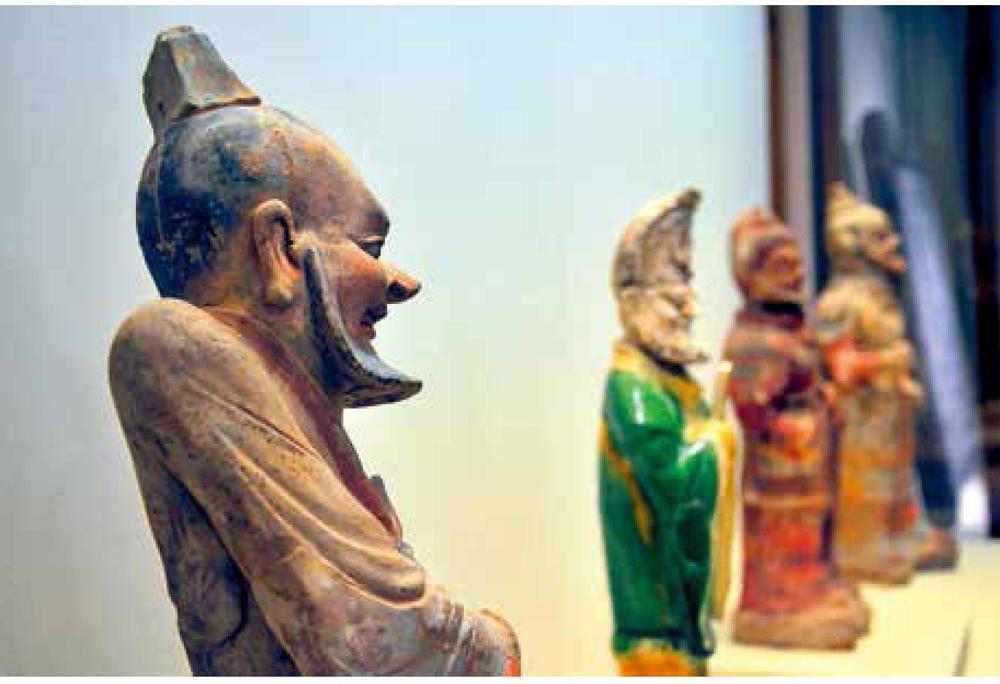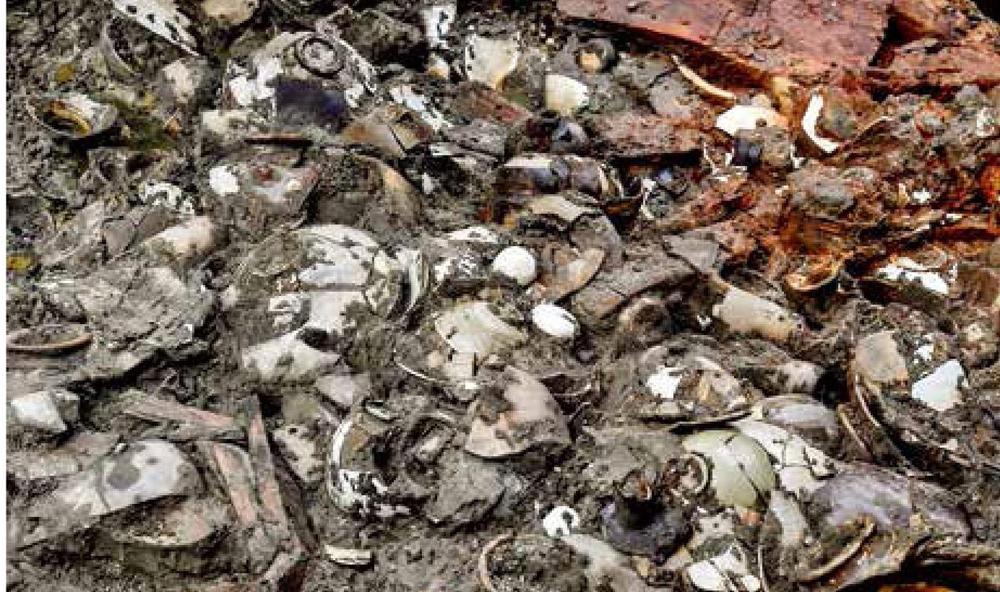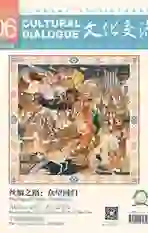此去经年多冷暖?桑叶应先知
2020-06-21赵丰



史学篇
丝绸之路其实并不是一条明确的路,只是一个通道,或是一个交通带。这是条东起中国、西达欧洲、连接欧亚大陆的交通带。丝绸之路的路线、兴衰、物品交流、作用及影响等,都值得不断地深入探讨和研究,这也是我们今天探索“丝绸之路经济带”的一份必要的历史资源。
丝绸之路这一名称由德国地理学家李希霍芬(曾七次到过中国)于1877年提出,此后,各种著述层出不穷,关于丝绸之路的概念也有所拓展,如海上丝绸之路、草原丝绸之路、西南丝绸之路等。
丝绸之路上还有许多鲜为人知的历史细节,同样值得一说。
丝绸之路,到底有几条路线
李希霍芬提出的丝绸之路,主要是指欧亚之间的一条陆路通道(后被称为沙漠绿洲丝绸之路),中途经过亚洲腹地,在干旱的沙漠、戈壁和高原中由绿洲相连而成。而中间又有分道,如從西安出发经河西走廊到敦煌后,就在新疆境内分为南、中、北三道,其中南、中两道到喀什又汇成一道,翻越帕米尔高原后进入中亚地区。通过乌兹别克斯坦、吉尔吉斯斯坦、塔吉克斯坦、土库曼斯坦等为主的中亚两河流域,到达伊朗高原,然后再到达地中海沿岸。其实,这一路线在中国古籍《隋书·裴矩传》中已有记载,虽然有所不同,但大体相似。
最早提出海上丝绸之路的或可以算是法国汉学家沙畹,1903年,他在其《西突厥史料》书中说到,丝绸之路可分为陆路和海路两条。1968年,日本三杉隆敏出版《探索海上丝绸之路》。而在中国,陈炎是最早关注和研究海上丝绸之路的学者,他于1980年正式提出这一概念,而后又发表了一系列关于海上丝绸之路的文章。至于海上丝绸之路的具体走向,则包括意大利、希腊、土耳其、埃及、阿曼、巴基斯坦、印度、斯里兰卡、泰国、马来西亚、印尼、文莱、菲律宾、中国、韩国和日本等国。
关于草原丝绸之路的提出,目前没有一个较为明确的说法。西方学者更多地将其称作草原之路,其实就是一条天然的草原通道。因为在欧亚大陆的地理环境中,北亚遍布寒冷的苔原和亚寒带针叶林,中亚又有崇山峻岭和戈壁沙漠,只有在北纬40度至50度之间的中纬度地区,才有利于人类的东西向交通。而这个地区恰好就是草原地带,向西可以连接中亚和东欧,向南越过阿勒泰山可以连接新疆,向东南则可通往中国的中原地区。
关于丝绸之路的路线,最有影响力的应数联合国教科文组织的丝绸之路项目——“丝绸之路的整体研究:对话之路”。这是自1988年开始、历时10年的大型学术活动,共进行了5次考察:1990年从西安到喀什的沙漠丝绸之路,1990~1991年从威尼斯到大阪的海上丝绸之路,1991年中亚草原丝绸之路,1992年蒙古游牧丝绸之路,以及1995年尼泊尔佛教丝绸之路。除了佛教丝绸之路这一小段亚洲国家之间的通道外,其余的就是沙漠丝绸之路、海上丝绸之路及草原丝绸之路(中亚草原丝绸之路和蒙古游牧丝绸之路,刚好是一条草原丝绸之路)。
中国境内的丝绸之路,应该有几条
关于中国境内的丝绸之路,中国学者徐苹芳在《考古学上所见中国境内的丝绸之路》文中提到有4条,一是汉唐两京(长安和洛阳)经河西走廊至西域路,这是丝绸之路的主道,它因通过新疆的塔克拉玛干沙漠和中亚的若干沙漠地区,被称为丝绸之路的沙漠路线;二是中国北部的草原丝绸之路;三是中国四川、云南和西藏的西南丝绸之路;四是中国东南沿海的海上丝绸之路。
从欧亚大陆上的东西文化交流通道来说,现在较为公认的丝绸之路有三大路线:沙漠绿洲丝绸之路、海上丝绸之路和草原丝绸之路。真正完整描述三条丝绸之路的学者要数著名中外交流史专家黄时鉴,他于1991年为中国丝绸博物馆展厅绘制了一幅网络式的丝绸之路全图,此图黄时鉴有专文论述,经他同意收录在赵丰主编的《中国丝绸通史》中。
西南丝绸之路,从四川进入西藏,过尼泊尔而到达印度,或经大理而入缅甸。但此后它又可以分为两路,一路可以北上到达中亚,融入沙漠丝绸之路,另一路南下连通海上丝绸之路。
海上丝绸之路形成的一个重要原因是阿拉伯人的海上航行技术,包括造船技术、帆船驾驶以及对海洋知识的积累。同时,人们对海洋知识的进一步了解和航海工具的创新,特别是指南针的应用和地图的绘制,使得海上丝绸之路的航行更加顺畅。
最早的丝绸之路,是在哪一块区域
丝绸之路是在世界文明发展的背景下形成的。从目前来看,丝绸之路的形成与发展可以分成三个大的阶段,以草原丝路为主的青铜时代到早期铁器时代,即从以沙漠和绿洲丝路为主的战国汉唐时期和以海上丝路为主的宋元明时期。
早在5000年前,欧亚大陆上的古代文明格局已经初步形成,古埃及、古巴比伦、古印度和古中国四大文明古国,分布在目前亚洲的主要区域,在欧洲则是米诺斯——迈锡尼文明,这一时期,人们对草原几乎一无所知。当整个世界进入青铜时代后,这些文明的区域都相对集中,在中间则是文明的过渡地带,而文明的交往选择了最为方便的草原途径,依赖游牧民族来进行。
于是,人们对辽阔无垠的草原民族开始有所了解。他们的活动地域,就在欧亚草原之上,从东到西,都有他们活动的身影。
虽然草原丝绸之路的很多贸易细节已不清晰,但其结果却十分明显,我们可以在希腊文献中读到大量关于丝绸的记载。维吉尔在《田园诗》中写道:“赛里斯人从他们那里的树叶上采集下了非常纤细的羊毛。”老普林尼在其《自然史》一书中生动地描述了赛里斯人和他们向树木喷水冲刷下树叶上的白色绒毛,并用此完成纺线和织造这两道工序。直到包撒尼雅斯(公元2世纪)开始,人们才知道丝绸来自一种叫蚕的昆虫,但他在《希腊志》中对蚕的描述却是“近似于蜘蛛”。
沙漠绿洲丝绸之路,何以在唐朝衰落
2000多年前,东西方分别发生了两件重大的事,对丝绸之路沙漠线的形成产生了巨大的影响。在西侧是亚历山大东征和罗马帝国的兴起,在东方则是汉武帝时期的张骞通西域。
公元前336年,亚历山大征服并统治了整个希腊。然后,他又开始了对东方的征战,歼灭了强大的波斯帝国军队,占领了印度的大部。但亚历山大去世后,曾经被他占领的土地就被他的部将分裂成了若干国家。
从汉武帝开始,位于东方的汉朝国力逐渐强盛,一方面他们与匈奴正面作战,另一方面也联合其他部落围攻匈奴。公元前139年,汉武帝派张骞出使西域,但张骞一出西域就被匈奴人所囚禁,若干年后逃回长安。公元前119年,张骞再次前往西域。这次,张骞偕同副使、将士等三百余人,携带牛羊万头、金币帛数千万从长安出发,在到达乌孙(今之新疆)后派副使去大宛、康居、大月氏、大夏等国(大宛相当于费尔干纳,康居相当于撒马尔罕,大月氏也在中亚地区,大夏位于阿富汗和巴基斯坦一带)。这样,一条在沙漠戈壁里行走、通过一个个绿洲连起来的丝绸之路就基本形成了。
一旦通道形成,大家都开始利用這一通道。丝绸之路沿途的国家或部落之间的使者、商人、僧人等都开始行走在这条通道上。由国家主导的军事力量也开始管理和维护丝绸之路的畅通。如汉代在西北地区的军事屯田,修筑的长城一直到敦煌一带。而唐代的疆土更为辽阔,四大都护府的建立,各处边关的运作,都在极力保护和经营着丝绸之路。这种情况一直到阿拉伯兴起,特别是在高仙芝一战之后唐朝放弃了对丝路的经营,中亚落入伊斯兰的手中,沙漠绿洲丝绸之路才逐渐衰落。
大量的南海沉船中,有没有发现丝绸
从中唐开始,中国西部逐渐分裂成若干势力范围,中原朝廷无力控制丝绸之路。与此同时,中国经济重心的南移,沿海港口的成熟,使东南地区的出海贸易变得十分活跃。唐朝于显庆六年(661年)在广州设置市舶司,广州成为中国海上贸易的重要港口。由于广州港外商云集,所以又在广州设蕃坊,专供外商居留。世界各地的商人们通过海路,前来购买中国的丝绸,同时也带来世界各地的商品,从晚唐到宋元,海上丝绸之路十分兴盛。
唐宋之际海上丝绸之路的兴盛,可以从大量的南海沉船中看出。1998年,属于唐晚期到五代初的黑石号沉船在印尼勿里洞岛海域附近出水,其中中国瓷器就达到6.7万多件。2003年,印尼爪哇附近海域又发现五代时的井里汶沉船,其中更有数万件浙江越窑瓷器。此外,中国海域中也发现大量南宋沉船,如著名的南海1号沉船属于南宋初年,华光礁1号沉船属于南宋中期。
这些沉船上虽然没有发现丝绸,但并不说明当时不存在丝绸。考古学家在南海1号沉船上发现了一个空舱,但中国丝绸博物馆科研人员采用基于免疫学原理的丝绸微痕检测技术,在舱底泥沙中发现了丝绸的残留物,说明这一舱内当时曾装载了丝绸。海上通道在隋唐时运送的主要大宗货物还是丝绸,而到了宋元时期,瓷器的出口渐渐成为主要货物,因此,人们也把它叫作“海上陶瓷之路”。
唐时的中国丝绸,在瑞典被发现
无可否认,丝绸在沙漠丝绸之路上占据着绝对的主导地位。目前发现的最早丝绸实物是战国时期的织锦和刺绣,在阿勒泰山北侧的巴泽雷克和乌鲁木齐附近的阿拉沟一带出土,说明了早期沙漠和草原之路的连接。
汉唐之间的丝绸大多数出自甘肃和新疆。特别是在甘肃敦煌,无论是汉代的烽燧遗址还是莫高窟藏经洞的唐代宝藏,都是丝绸之路的重要见证。在叙利亚的帕尔米拉也发现了中国的丝绸,这个罗马时期遗址中发现的中国丝绸,其风格与中国境内发现的汉锦完全一样。唐代前后的中国丝绸,甚至还在北欧挪威和瑞典维京时期的遗址中发现,这些丝绸无疑是被人们转运到那里的。
丝绸在海上的发现虽然没有实物,但佐证材料很多。印度尼西亚的世界文化遗产婆罗浮图,是9世纪东南亚最大的佛教造像群,其中也有着模拟织锦的图案,显然是唐代的联珠团窠织锦纹样。在12世纪至13世纪的印尼佛像中,也有大量球路纹样与宋代前后流行的球路纹锦相同。
大量西洋布,通过海路传入中国
西洋布,是指来自海上丝绸之路的棉纺织品,这一名词首见于元代。
棉的起源地无疑是在南亚次大陆,在印度河流域的摩享朱达罗遗址中已经发现了棉织物。在汉晋时期,棉布从北印度一带通过沙漠绿洲丝绸之路向中国西北地区传播。新疆一带的汉晋时期墓地中基本上都有棉布出土,最为有名的一件是尼雅遗址的蜡染棉布,其上有提喀女神、赫拉克利斯等希腊化艺术造型。到唐代,棉花在新疆已得到栽培,并在敦煌一带得到纺织。
对于棉布来说,更为重要的道路是海路。宋赵汝适《诸蕃志》经常提到海上丝绸之路上棉布的贸易,不过,当时东南亚一带不仅有棉布贸易,而且棉纺织生产也已十分发达。元代黄道婆在海南黎族学到棉纺织技术然后再传播到松江一带的故事,就说明了东南亚棉纺织生产的发达。
赵孟頫就曾收到僧人晋之送他的西洋布。更有意思的是,西洋布还曾在江西明墓中出土。益宣王朱翊鈏墓中出土了一块写有墨书“西洋布”的棉布,可能是目前所知唯一有明确依据的明代进口棉布。此外,意大利人利玛窦在明末北上觐见明神宗时,也带去了“大西洋布与葛布共五匹”。
明朝黄省曾在《西洋朝贡典录》中也提到了东南亚各国对中国的贡物中有很多纺织品,其中大部分都是棉布,如芜蔓番纱、红印花布、油红绵布、圆壁花布、番花手巾、番花手帕、兜罗绵被、苾布、西洋布、缠头布等,种类十分丰富。
在丝路上,丝绸还是一种货币
丝绸在丝绸之路上扮演的角色不光是一种商品,而且还是一种货币。很多大宗贸易就是用丝绸作为货币进行交易的,特别是牲口和奴婢。当时敦煌和吐鲁番一带的马价一般在15匹练左右,较次的在10匹练左右,而奴婢的买卖价格有时是40匹练。
用丝绸作为货币的另一个好处是丝绸不会贬值。丝绸之路沿途,特别是在中国的西北地区,流通着波斯银币、铜币和丝织品三种货币。根据对吐鲁番文书的研究,唐武周年间(690年前后)和天宝时期(745年前后)的55年间,银币与丝织品之间的兑换率一直是一匹练换十文银,而铜钱则从一文银换32文铜贬值到一文银换46文铜,贬值约30%。很显然,相对来说,绢练对于中西诸方来说具有公认的价值、较高的信誉,因此,它在丝路沿途可以作为硬通货来使用。
絲绸交易,带来了民族的融合
在早期的丝绸之路上,和亲与派遣使者是部落间常见的联络方式,无论是王昭君、文成公主和亲,还是张骞出塞,带去的是丝绸和物品,带来的则是血缘上的融合。一个著名的例子就是传丝公主。据《大唐西域记》载:“昔者此国,未知桑蚕,闻东国有之,命使以求。时东国君秘而不赐,严敕关防,无令桑蚕种出也。瞿萨旦那王乃卑词下礼,求婚东国……命使迎妇而诫曰:我国素无丝绵桑蚕之种,可以持来,自为裳服。女闻其言,密求其种,以桑蚕之子,置帽絮中。”于是蚕种就这样传入了瞿萨旦那(今新疆和田一带)。
同样是因为丝绸的贸易,大批商人和商队的来往也带来了民族的交往。如丝路上最大的经商部落粟特人,长期住在丝绸之路沿途,在碎叶、喀什、和田、敦煌、长安、太原、大同等地形成了巨大的聚落。近年在太原、西安等地发现的虞弘墓、安迦墓等,都说明了粟特人在各地的散布。由于其长期在外,他们与外族通婚或交往,甚至信仰不同的宗教,因此也带来了民族融合。
由海路而来的阿拉伯商人也是如此。他们居住在中国东南沿海的港口,特别是广州和泉州。广州一地,在唐末已有几十万外商居留,而泉州一地,在宋元时达到极盛。13至14世纪的叙利亚人阿伯尔肥达、威尼斯旅行家马可·波罗和摩洛哥旅行家伊本·巴都他等,都在他们的游记中描绘“刺桐港”(泉州港古称)的繁荣景象,誉称它是世界最大的商港之一,甚至出现了“回半城”的状况。这些居民有着不同的宗教信仰,促使不同的宗教得以传播,如摩尼教、拜火教、佛教、基督教等。随着宗教的传播,民族的融合也变得更为方便。
养蚕技术从中国传到欧洲,用了4个世纪
丝绸之路是文化交流之路,这其中包括科技、艺术、生活等各个方面。在科技交流方面,自然有地理学、天文学、数学、物理、化学、农业、医药、交通等的交流。艺术的交流也无处不在,如音乐、舞蹈、壁画、丝绸、金银器、陶瓷、绘画等。
纺织材料的交流则主要体现在毛、丝、棉的传播上。养羊、羊毛利用和加工的技术传播,可能早在青铜时代已经基本完成。但养蚕技术的西传,则主要在2世纪至6世纪之间。2世纪至3世纪,养蚕技术传入西北地区,所以在新疆有了蚕茧的发现和传丝公主的故事,而养蚕技术传入中亚,应该是在4世纪至5世纪间,导致了粟特锦和波斯锦的兴盛。养蚕技术传入小亚细亚,应该是在6世纪初。据泰奥法纳(750~817年)介绍,在查士丁尼(483~565年)统治期间,一位波斯人曾在拜占庭介绍过有关蚕虫的起源问题,这是中国养蚕技术传入欧洲的最早记载。棉纺织生产技术则至迟在唐朝已传入中国西北,到元代则传遍中原大地。
The Silk Road was coined in 1877 by Ferdinand von Richthofen, a German geologist who visited China seven times. The concept has touched off a wide range of studies since then. Many scholars prefer to call the Silk Road as Silk Routes as there are many routes in history thorough which silk trade from China to the west was carried out. The Silk Road does not refer to a single trade route. This was a channel of exchanges connecting China in the east and Europe in the west. The specific routes, appearance and disappearance of these routes, commodities carried through these routes, functions and influences of these commodities are subjects worth further studying and exploring. The ancient Silk Road is a history we must understand while exploring the Road and Belt.
Multiple Silk Trade Routes
The Silk Road described by Ferdinand von Richthofen mainly refers to an overland route between Asia and Europe, a route that went through deserts, the Gobi, and oases. Such a trade route diverged and converged before it went into central Asia and then Iran before it reached the Mediterranean Sea.
The French sinologist ?douard ?mmannuel Chavannes (1865-1918) claimed in 1903 that there existed a maritime silk road between China and Europe. The Silk Road, in his opinion, was composed of a maritime route and an overland route. In 1968, a Japanese scholar also explored the Maritime Silk Road in a book. In China, Chen Yan was the earliest scholar who concerned himself with the study of the Maritime Silk Road in 1980. Chen then published a series of articles further exploring the shipping routes that connected China and countries in other parts of Asia and Europe. Some scholars have suggested the existence of Grassland Silk Road. But this route expects more studies and researches.
The most influential study about multiples silk trade routes was conducted by the UNESCO from 1988 to 1998. The ten-year project saw five field studies. In 1990, scholars explored the route from Xian to Kashgar in Xinjiang. From 1990 to 1991, experts looked into a maritime silk road from Venice to Nagasaki. In 1991, experts probed the grassland silk route that reached the central Asia. In 1992, experts examined the silk route operated by the nomads through Mongolia. In 1995, experts probed the silk trade route opened by Buddhist disciples that connected China and Nepal.
Multiple Silk Routes in China
There were four silk routes across China. The major route started from Changan and Luoyang and went westward through a long corridor west of the Yellow River into Xinjiang. This road thrived during the Han Dynasty (206BC-220AD) and the Tang Dynasty (618-907). The second route went through the north of China. It is known as the Grassland Silk Road. The third route zigzagged through Sichuan, Yunnan and Tibet in the southwest of China. The fourth route was the Maritime Silk Road that went south and west from the coastal provinces of eastern China.
The Earliest Silk Road
The silk routes responded to the development of civilizations across the world. Studies indicate that silk routes formed and extended through three different periods. The first silk route formed in the bronze era and the early iron era and went westward through the grasslands. The route that went through deserts and oases thrived in the Warring States, the Han and the Tang dynasties. The Maritime Silk Road thrived in the Song, the Yuan and the Ming dynasties. Silk was carried on to the west through grasslands by nomads.
The Silk Road Blocked inthe Tang
Over two thousand years ago, two things happened in the west and the east that seriously impacted the Silk Road through the deserts. In the west, the rise of the Rome Empire and the eastward expedition of Alexander the Great changed the map of the world. In the east, Zhang Qian (?-114BC), a diplomat of the Western Han (206BC-8AD), opened up a trade route to the west. A route that went through deserts and connected one oasis with the next took form as Zhang Qian trekked westward. The road was utilized by people such as diplomats, traders and monks in the states along the road. The road was kept open by military forces of the states and the Tang. However, as the Tang forces were defeated in 751 by an Arab army in battle at Talas River near Samarkand, the overland Silk Road was blocked.
Any Silk in Sunken Ships found in Southeast Asia?
In the middle of the Tang, the Chinese government gave up the control of the Silk Road and the western region of China fell apart. Meanwhile, the economic center shifted to the south, and ports in southeastern China thrived. The Maritime Silk Road started in 661 when a government office was set up in Guangzhou to administer international trade affairs. From the sunken ships found in the Southeast countries in modern times, a lot of porcelain products from China were salvaged. At the bottom of South Sea No. 1, a Chinese cargo ship of the Southern Song Dynasty that sank on its outbound journey, scientists studied the sediments on the bottom of the ship and found traces of silk. The evidence indicates that the ship carried some silk products in its cargo holds. In the Sui and the Tang Dynasty, ships that sailed out to overseas destinations carried silk as a major product. It was in the Song (960-1279) and the Yuan (1279-1368) dynasties that porcelain replaced silk as the major commodity.
Silk Found in Sweden
Silk was the major commodity on the Silk Road zigzagging through deserts and oases. Archaeologists have found silk remains from tombs both in Xinjiang and Pazyryk cemetery. The silk was manufactured in the Warring States period of China. The silk remains found in Gansu and Xinjiang go back to the Han and the Tang dynasties. Chinese silk made in the Tang has been found in Norway and Sweden. Though no silk has been directly found to indicate silk was shipped from China to overseas destination, there is indirect evidence. Buddha sculptures of the 9th century in Southeast Asia feature fabric patterns that look apparently like those made in the Tang Dynasty. Some Buddha sculptures of the 12th and 13th centuries in Indonesia present fabric patterns made in the Song Dynasty.
Cotton Fabrics Shipped to China
Cotton-woven fabrics originated in the South-Asian Subcontinent. In Chinas Han (206BC-220AD) and the Western Jin periods (265-316), cotton fabrics were carried to China through the overland Silk Road from the northern India. Excavated from the tombs in Xinjiang that date back to the Han and the Western Jin are some cotton fabrics. In the Tang Dynasty, cotton as a crop was cultivated in Xinjiang. In the Song Dynasty, cotton fabrics were shipped in large quantities to China through the Maritime Silk Road. Books written in the Song and the Yuan mention cotton fabrics imported from the “Western Sea”, a then common epithet for the fabrics made in the South Asian Subcontinent.
Silk as Currency
On the silk routes, silk was more than a commodity that changed hands. In some cases, it was a hard currency in trade. In some bid deals, silk was used as currency to buy livestock and slaves. According to ancient documents, a horse could be bought for 15 bolts of silk in Dunhuang and Turpan. In the Tang Dynasty, three kinds of currencies were used: Persian silver coins, copper coins of the Tang, and silk.
Ethnic Fusion through Silk Trade
Business people came with caravans to China in early years. Among them were Sogdians in the region of Maracanda (modern Samarkand). Along the silk roads were many settlements of Sogdians. These settlements were in present-day Suyab, Kashgar, Hetian, Dunhuang, Changan, Taiyuan, and Datong. They married outside their tribes and converted to some other religions. Arabs who came to China through the Maritime Silk Road also set up large settlements in China. Especially, Guangzhou and Quanzhou were two large cities where international communities were large toward the end of the Tang. Quanzhou in Fujian was a port city where Arabs formed a large community. These foreigners spread their religions in China.
Sericulture Traveled Four Centuries to Reach Europe
The Silk Road was a road that also promoted cultural exchanges and communication. What went through the silk routes included geology, astronomy, mathematics, physics, chemistry, agriculture, medicine, transport skills, music, dance, murals, silk, gold and silver gadgets, porcelain, and painting.
Sericulture and silk craftsmanship appeared in Xinjiang in the 2nd to 3rd centuries. From Xinjiang, it continued to move westward and prospered in central Asia in the 4th to 5th centuries. It spread to Minor Asia in the early 6th century. According to history, during the rule of Justinian the Great, a Persian talked about the genesis of silkworm in Byzantine. This is the earliest mention of silkworm in European literature.
